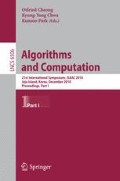Abstract
We describe a data structure, called a priority range tree, which accommodates fast orthogonal range reporting queries on prioritized points. Let S be a set of n points in the plane, where each point p in S is assigned a weight w(p) that is polynomial in n, and define the rank of p to be \(r(p)=\lfloor \log w(p) \rfloor\). Then the priority range tree can be used to report all points in a three- or four-sided query range R with rank at least \(\lfloor \log w \rfloor\) in time O(logW/w + k), and report k highest-rank points in R in time O(loglogn + logW/w′ + k), where W = ∑ p ∈ S w(p), w′ is the smallest weight of any point reported, and k is the output size. All times assume the standard RAM model of computation. If the query range of interest is three sided, then the priority range tree occupies O(n) space, otherwise O(nlogn) space is used to answer four-sided queries. These queries are motivated by the Weber–Fechner Law, which states that humans perceive and interpret data on a logarithmic scale.
Access this chapter
Tax calculation will be finalised at checkout
Purchases are for personal use only
Preview
Unable to display preview. Download preview PDF.
References
Afshani, P., Barbay, J., Chan, T.M.: Instance-optimal geometric algorithms. In: Proc. 5th IEEE Symposium on Foundations of Computer Science, pp. 129–138 (2009)
Agarwal, P.K.: Range searching. In: Goodman, J.E., O’Rourke, J. (eds.) Handbook of Discrete and Computational Geometry, pp. 575–598. CRC Press LLC, Boca Raton (1997)
Agarwal, P.K., Erickson, J.: Geometric range searching and its relatives. In: Chazelle, B., Goodman, J.E., Pollack, R. (eds.) Advances in Discrete and Computational Geometry, Contemporary Mathematics, vol. 223, pp. 1–56. AMS, Providence (1999)
Alstrup, S., Stolting Brodal, G., Rauhe, T.: New data structures for orthogonal range searching. In: Proc. 41st IEEE Symposium on Foundations of Computer Science, pp. 198–207 (2000)
Baeza-Yates, R., Castillo, C., López, V.: Characteristics of the web of spain. International Journal of Scientometrics, Informetrics, and Bibliometrics 9 (2005)
Bent, S.W., Sleator, D.D., Tarjan, R.E.: Biased search trees. SIAM J. Comput. 14, 545–568 (1985)
Bentley, J.L.: Multidimensional divide-and-conquer. Commun. ACM 23(4), 214–229 (1980)
Boore, D.: The Richter scale: its development and use for determining earthquake source parameters. Tectonophysics 166, 1–14 (1989)
Brin, S., Page, L.: The anatomy of a large-scale hypertextual web search engine. Comput. Netw. ISDN Syst. 30(1-7), 107–117 (1998)
Chazelle, B.: Filtering search: a new approach to query-answering. SIAM J. Comput. 15, 703–724 (1986)
Chazelle, B.: A functional approach to data structures and its use in multidimensional searching. SIAM J. Comput. 17(3), 427–462 (1988)
Chazelle, B., Guibas, L.J.: Fractional cascading: I. A data structuring technique. Algorithmica 1(3), 133–162 (1986)
Dehaene, S.: The neural basis of the Weber-Fechner law: a logarithmic mental number line. Trends in Cognitive Sciences 7(4), 145–147 (2003)
Driscoll, J.R., Sarnak, N., Sleator, D.D., Tarjan, R.E.: Making data structures persistent. Journal of Computer and System Sciences 38(1), 86–124 (1989)
Dujmović, V., Howat, J., Morin, P.: Biased range trees. In: Proc. 19th ACM-SIAM Symposium on Discrete Algorithms, pp. 486–495. SIAM, Philadelphia (2009)
Evans, J.: The history & practice of ancient astronomy. Oxford University Press, Oxford (October 1998)
Floyd, R.W.: Algorithm 245: Treesort 3. Commun. ACM 7(12), 701 (1964)
Frakes, W.B., Baeza-Yates, R. (eds.): Information retrieval: data structures and algorithms. Prentice-Hall, Inc., Upper Saddle River (1992)
Fries, O., Mehlhorn, K., Näher, S., Tsakalidis, A.: A loglogn data structure for three-sided range queries. Inform. Process. Lett. 25, 269–273 (1986)
Hecht, S.: The visual discrimination of intensity and the Weber-Fechner law. Journal of General Physiology 7(2), 235–267 (1924)
Lueker, G.S.: A data structure for orthogonal range queries. In: Proc. 19th IEEE Symposium on Foundations of Computer Science, pp. 28–34 (1978)
McCreight, E.M.: Priority search trees. SIAM J. Comput. 14(2), 257–276 (1985)
Mehlhorn, K.: Nearly optimal binary search trees. Acta Informatica 5(4), 287–295 (1975)
Morrison, J., Roser, S., McLean, B., Bucciarelli, B., Lasker, B.: The guide star catalog, version 1.2: An astronomic recalibration and other refinements. The Astronomical Journal 121, 1752–1763 (2001)
Overmars, M.H.: Efficient data structures for range searching on a grid. J. Algorithms 9, 254–275 (1988)
Page, L., Brin, S., Motwani, R., Winograd, T.: The PageRank citation ranking: Bringing order to the web. Technical Report 1999-66, Stanford InfoLab, previous number = SIDL-WP-1999-0120 (November 1999), http://ilpubs.stanford.edu:8090/422/
Richter, C.F.: Elementary Seismology. W.H. Freeman and Co., New York (1958)
Satterthwaite, G.E.: Encyclopedia of Astronomy. Hamlyn (1970)
Author information
Authors and Affiliations
Editor information
Editors and Affiliations
Rights and permissions
Copyright information
© 2010 Springer-Verlag Berlin Heidelberg
About this paper
Cite this paper
Goodrich, M.T., Strash, D. (2010). Priority Range Trees. In: Cheong, O., Chwa, KY., Park, K. (eds) Algorithms and Computation. ISAAC 2010. Lecture Notes in Computer Science, vol 6506. Springer, Berlin, Heidelberg. https://doi.org/10.1007/978-3-642-17517-6_11
Download citation
DOI: https://doi.org/10.1007/978-3-642-17517-6_11
Publisher Name: Springer, Berlin, Heidelberg
Print ISBN: 978-3-642-17516-9
Online ISBN: 978-3-642-17517-6
eBook Packages: Computer ScienceComputer Science (R0)

